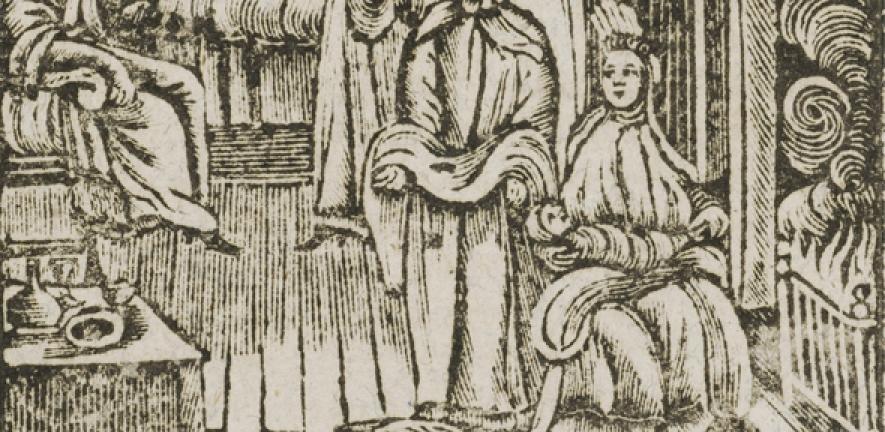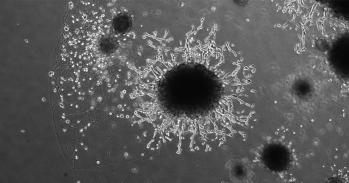
The management of childbirth and care of newborns have always been hotly-debated topics. PhD candidate Leah Astbury looks at narratives of reproduction in the 16th and 17th centuries and finds evidence for many of the same concerns.
The management of childbirth and care of newborns have always been hotly-debated topics. PhD candidate Leah Astbury looks at narratives of reproduction in the 16th and 17th centuries and finds evidence for many of the same concerns.
Let it [the baby] haue a full breast of new milke at command and all the quiet and content
Joan D'Ewes writing to her sister Ann, mid-17th century
In 1697, Matthew Henry, a Presbyterian minister, wrote to his mother about the health of his family. His letter survives in a collection of family correspondence in the British Library, although its immediate context is hazy. Matthew recalls returning from business to find his infant daughter, Nancy, close to death.
A doctor is called. Matthew states that the physician “was very apprehensive of her peril” and attributed Nancy’s illness to “the badness of her Mother’s Milk”. Matthew’s wife was forbidden by the doctor from breastfeeding the child any longer, an instruction which Matthew recorded “put her in much adoe”. He concluded his letter by informing his mother that “we got a wet nurse into the house”, which, as the doctor promised, returned Nancy to health.
Contemporary documents like this one reveal that early modern women from relatively affluent families desired to breastfeed, and in some cases were successful at breastfeeding, their infants themselves. Hiring a wet nurse was not a universal practice, and when parents were compelled to resort to outside help, the infant and wet nurse were sometimes accommodated within the home itself.
Scholars have previously argued that only royal babies enjoyed the proximity of both their mother and wet nurse, and that middling and upper class families invariably sent their infants away from home to live with the wet nurse and her family until weaning was judged appropriate.
Henry’s letter provides a small but intimate window into the relationship of parents, medical practitioners and infants in 17th-century England. Mortality rates in early modern England were high and parents knew that their children might well not survive infancy, let alone reach adulthood. It has been estimated that a quarter of all infants did not reach their first birthday. Neonatal death was particularly common.
Nevertheless, parents were eager to employ all kinds of means to secure the ongoing health of their offspring after birth. Matthew and his wife knew the life of the infant Nancy was precarious but they also knew that she could be saved. Vignettes such as theirs indicate that when infant illness occurred, parents were flexible in their post-natal regimes, willing to make changes, and loving and tender in their concern for their offspring.
My research looks at the theory and practice of maternal and infant health, and how their respective bodies were perceived to function in relation to one another. I am part of the Wellcome Trust funded Generation to Reproduction project at the University of Cambridge, a group of scholars investigating the history of reproduction from ancient to contemporary times. My work focuses on pregnancy, childbirth and post-natal care, bringing personal documents to bear on published medical literature in order to investigate the intersection between prescriptive advice and practice.
Sources such as diaries, correspondence and journals offer a fresh perspective on older debates about the practice of medicine within the home and bodily understanding in the past. Still at an early stage, my research into documents such as these has already thrown up a number of surprises.
Perhaps the most interesting discovery is the frequency with which babies were bathed and cleaned in the 16th and 17th centuries. Current NHS guidelines recommend refraining from submersing newborns in water for a full week after birth, to preserve the protective white substance that covers the baby’s skin at birth to prevent dryness and cracking. After this initial period, the NHS recommends washing newborn babies in plain water once or twice a week. In contrast, 16th- and 17th-century medical authorities recommend baths at least once a day and sometimes as often as three or four times a day.
This finding – evident in the regimes printed in childbearing manuals - challenges popular assumptions about the comparatively lax attitude to personal hygiene of Tudor and Stuart society.
Early modern infants were swaddled (tightly wrapped) shortly after birth. Medical texts provided instructions to parents and nurses as the best way to bind the infant body to support the body and make the limbs grow straight. Other sources indicate that this appears to have been standard practice. Infancy is typically represented on funerary monuments as a swaddled figure. Other representations of swaddling include the famous image, on display at Tate Britain, of the Cholmondeley sisters tenderly holding their wrapped infants.
No clear time limit confined the period of swaddling. Parents were advised by medical writers to observe the baby’s movement. When infants appeared frustrated by their bindings and moved their arms, their limbs were released, usually at four months old. The entire body was freed at a later stage, sometimes up to a year after birth, depending on an assessment of the baby’s health.
Older histories of the early modern family have tended to see swaddling as emblematic of the perceived negligence and abuse of children by their parents.
However, post-natal schedules set out in medical literature suggest that the process of swaddling and changing the infant was couched in terms that allowed regular periods of physical intimacy and affection between mother or nurse and infant.
Contemporary sources suggest that the infant was ritually bathed, rubbed and stroked, before being carefully dried and wrapped in clean swaddling cloths. Wadges of ‘clouts’, or cloths, were placed to act as a kind of nappy. To me, it seems that swaddling provided an opportunity for parents and other caregivers to be physically close to the infant; it was not an act of emotionally distancing the newborn as previous scholars have argued.
The fact that wrapping of newborns remains popular today is one of the many reasons why I have chosen to do my research. So many of our social, cultural, emotional and medical values and understandings are reflected in the way we care for our young. Pregnancy, childbirth and post-natal care are subject to trends and fashions, whether they are endorsed through social or medical arguments. Infant and maternal healthcare has always been hotly contested, because it is an activity involving not just parental reputation and identity but also the perpetuation of communities.
An examination of things which we care about deeply can reveal the discontinuities but also equally as important the continuities between past and present. The media coverage surrounding the arrival of the Duke and Duchess of Cambridge’s baby is picking up the same themes that were prominent in early modern sources, among them pain relief during labour and the post-natal schedule of sleeping and feeding.
Even our concept of demand feeding, which has recently become part of the new movement of attachment parenting, has an earlier precedent. Correspondence between two sisters – Ann D’Ewes and Joan Ellyot – that survives in the D’Ewes family papers at the British Library shows that debate about the pros and cons of imposing a regime on a baby or allowing it to sleep and feed on demand was as alive in the mid-17th century as it has been over the past few decades.
When Ann’s infant son was ailing, Joan wrote to her with urgent advice. Joan told Ann to stop breastfeeding the infant herself, for the baby’s ailing state was a powerful indication that Ann’s breast milk was corrupt and “stale”. Instead, Joan suggested that Ann should hire a wet nurse, whom she should house at home so she could monitor the diet and conduct of the hired nurse. The baby ought not to be “kept from sleepe or suck which I know has bin the way of very good docters in this case but let it haue a full breast of new milke at command and all the quiet and content”.
In a similarly liberal vein, that would find favour with many modern baby manuals, the Welsh medical writer John Jones wrote in 1579 parents and nurses must “take it [the baby] uppe and laye it downe as ofte as neede shal require”.
An exploration of the way in which the infant body was perceived to function, and how its needs were to be met, in the past reveals the impressive flexibility of parents in attending to their offspring. Parents engaged actively in the care of their babies and read bodily signs to predict infants’ medical needs. Most strikingly however, post-natal narratives reveal the physical affection which parents bestowed on their offspring in bathing, swaddling, feeding and lulling babies to sleep and how parents were deeply concerned to ensure their offspring survived.
For more information on this story contact Alex Buxton, Office of Communications, University of Cambridge amb206@admin.cam.ac.uk 01223 761673.
This work is licensed under a Creative Commons Licence. If you use this content on your site please link back to this page.





